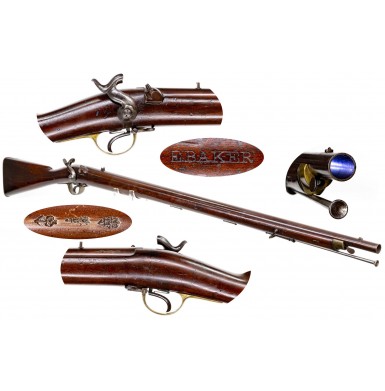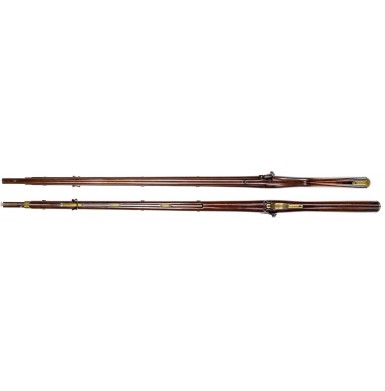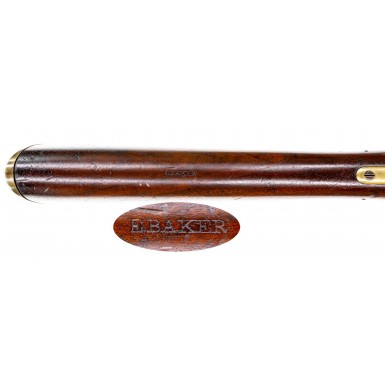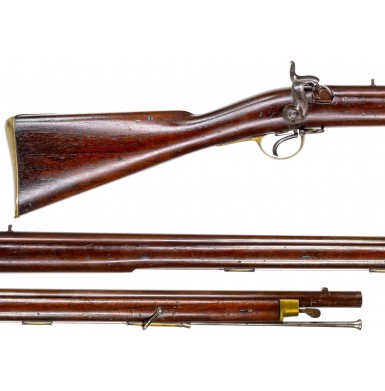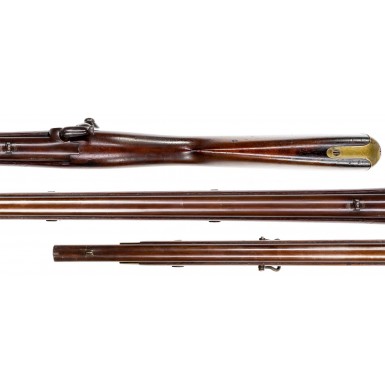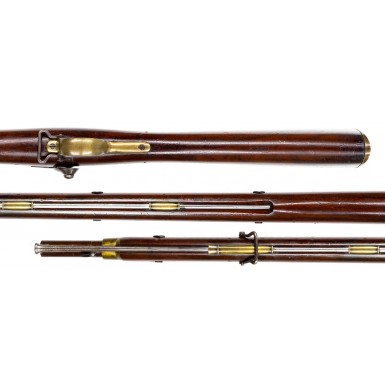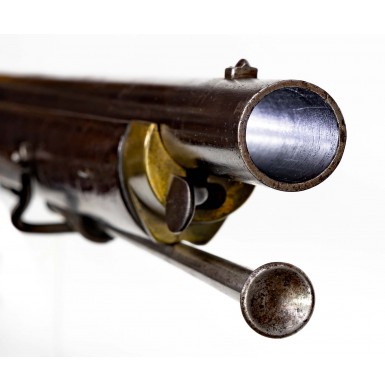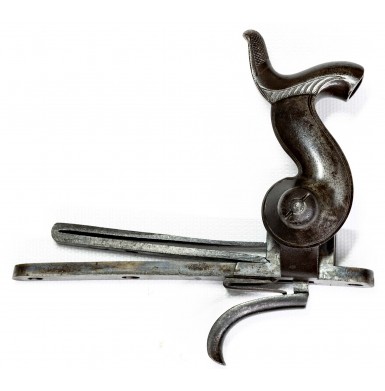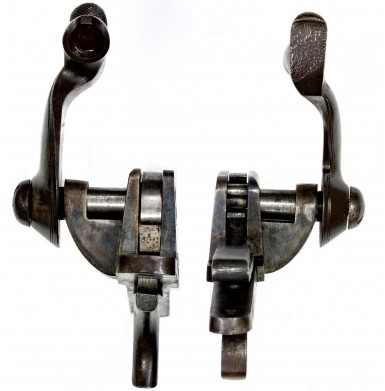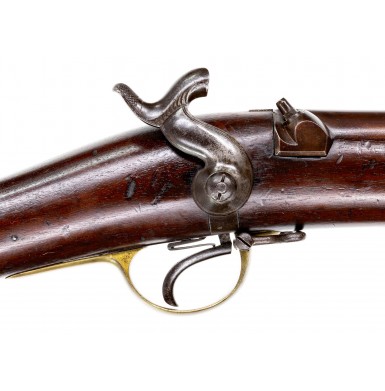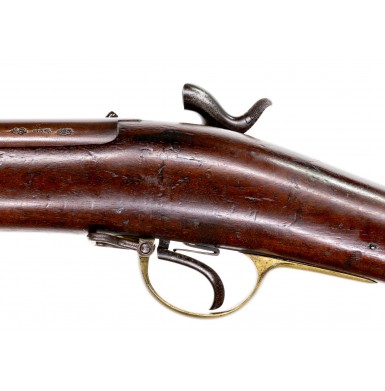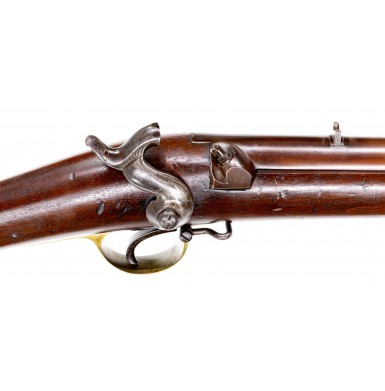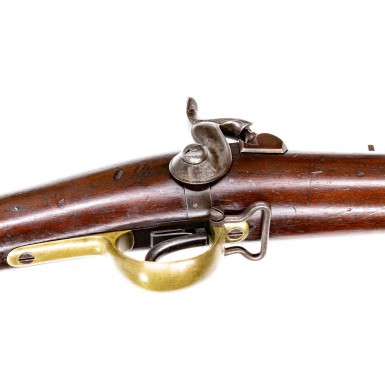Experimental Ezekiel Baker Inside Lock British Military Musket
- Product Code: FLA-3774-SOLD
- Availability: Out Of Stock
-
$1.00
The period from about 1850 to 1855 was quite turbulent within the British Board of Ordnance as a new direction was being taken in the design of small arms for the British Army. In that short period of time the average British line infantry solider went from carrying a nominally .75 caliber smoothbore musket to a .577 caliber rifle musket, drastically changing the capabilities of the British infantry that had been essentially unchanged since the 1750s.
In 1840, George Lovell had been made Inspector of Small Arms and though he had been helping to design and develop small arms for some two decades prior to that appointment, it was the 1840 appointment that finally placed him in the position to have one of his primary development goals realized, the adoption of a rifled arm for general issue to all members of the British military. Lovell had been fixated since the 1830s on the development of a superior percussion ignition musket, which culminated in his Pattern 1838 Musket. This was a back action lock design that was significantly superior in quality and efficiency to the current production front action locks. While this pattern was initially adopted, the economic need to use up existing stocks of older flintlock pattern parts, as well as to potentially alter earlier flintlock muskets, resulted in Lovell’s Pattern 1838 design being set aside. Instead, the new Pattern 1839 Musket was adopted, essentially a New Land Pattern Musket with a percussion, rather than flint ignition system. This meant the Pattern 1839 was nearly identical to earlier flint muskets, with only the lock and breech being significantly different. The fire that destroyed much of the Tower of London armories and workshops on October 30, 1841 destroyed more than 280,000 small arms in inventory. This freed Lovell to start a more radical move away from the traditional flintlock pattern that had been forced upon the Ordnance Department from the restrictions of economy and allowed the freedom to start developing better arms.
The next pattern to be adopted was the Pattern 1842 Musket, a refined and better designed variant of the Pattern 1839. Like the Brown Bess muskets dating back to the mid-18th century, the guns were still nominally .75 caliber and smoothbore. Lovell, however, was still looking for a way to reequip the British military with rifled arms, rather than smoothbores. This required finding a way to use sub-caliber ammunition that could be loaded as quickly as a smoothbore, but that was capable of expanding when loaded or fired to effectively use the rifling. Numerous solutions were experimented with during the 1840s, primarily using the various French systems like the Thouvenin and Delvigne breeches. However, it was Minié’s system of sub-caliber, expanding base ammunition that finally solved the most pressing problem regarding the issue of rifled arms to all soldiers. Lovell began working overtime, in conjunction with the British military’s Committee on Small Arms. The first result was a smaller caliber, rifled arm with a .702” bore and long range rear sight, designated the Pattern 1851 Minié Rifle. Again, the overall design looked little different than earlier flintlock and percussion muskets with pinned and later wedge retained barrels, no barrel bands and ramrod pipes, in a style little changed since the 1750s. Almost immediately a more advanced, smaller caliber rifled long arm was under development.
1852 saw a huge number of designs and concepts evaluated and eventually tested by the Committee on Small Arms. The details of this study was later published as the Report of Experiments with Small Arms Carried on at the Royal Manufactory, Enfield, 1852. A large number of designs and concepts were submitted for initial evaluation but in the end only five manufacturers were selected for a final intensive testing of their designs. The various makers understood that beyond contracts to produce arms for the British government one of the most lucrative things a gunmaker could do was to develop and patent a design that would be adopted as a feature in a British military arm. Adoption of such a patented system would result in either a large lump sum payment to the designer by the government or the repeated payment of royalties based upon the numbers produced. During the period when the Pattern 1839 and Pattern 1842 muskets were being developed, the automatic priming system of Baron Heurteloup was experimented with and similarly during this period an underhammer design by Wilkinson was evaluated as well. By the 1850s the general belief among the gun makers was that the patented features most likely to be adopted by the Committee on Small Arms were either a lock design, or rear sight design or a system of rifling. As a result, large numbers of innovative and patent protected innovations flooded the Small Arms Committee and Lovell as they proceeded to try to develop the next step beyond the Pattern 1851 Minié Rifle, which would eventually result in the Pattern 1853 Enfield.
One of the London gunmakers that was interested in designing a lock for potential British military use was Ezekiel Alexander Baker, the son of Ezekiel John Baker. The senior Baker’s name is forever associated with the British military of the Napoleonic era as the inventor of the flintlock military long arm that bore his name, the Baker Rifle. Ezekiel Baker the elder was born in 1758 and was apprenticed to the famous Henry Nock. Nock was another innovator in British military long arms and was responsible for the development of several patterns of guns, the Nock “screwless” lock and most famously the Nock Volley Gun. Upon the completion of apprenticeship under Nock, the elder Baker remained in Nock’s employ during the years from 1785-1787. After leaving Nock to work on his own, Baker initially set himself up as a “gun barrel maker” at 8 Fieldgate Street, but by 1791 was advertising as a “gun maker”. From 1791-1804 Nock worked at 23 Little Allie Street. In 1804 he moved to 24 White Chapel Road and also added an additional location at Pall Mall in 1814 as well as his own private proof house at Size Yard. The establishment of this private proof house became a significant bone of contention between Baker and the Worshipful Company of Gunmakers, who operated the London Proof House and were opposed to any competition to their monopoly. One of Baker’s early successes was to become an official contractor to the British Board of Ordnance in 1794, followed by becoming a gunmaking contractor to the East India Company in 1803. In 1800 his rifle design was adopted by the Board of Ordnance as the Baker Rifle, and he authored Remarks on Rifle Guns in 1801. Baker also invented improved flintlock mechanisms, bayonets and bullet molds, as well as a gun stocking machine (Blackmore). In 1816 he was awarded a Silver Medal by the Royal Society of Arts for his innovations and received additional Silver Medals in 1821 and 1822. In 1823 the firm became Baker and Son when his eldest son Ezekiel John Baker Jr joined the family business. Ezekiel Baker the elder died in 1836, leaving his eldest son to operate the business. Ezekiel John Jr continued as a contractor to both the Board of Ordnance and East India Company until his death in 1841. At this time, Elizabeth Sophia Baker, the widow of Ezekiel Sr took control of the business and ran it with the help of her younger son Ezekiel Alexander Baker, who was 18 at that time. Ezekiel Alexander had almost certainly started his apprenticeship under his father’s tutelage in the 1830s and continued his apprenticeship under his elder brother after their father’s death. Ezekiel John was apparently an innovator like his father and received two British patents, #141 (1851) and #3208 (1852) for “improved gun locks”. One of these patents was apparently for an “inside lock” similar to that designed by southerner George Morse, who oversaw the production of a few hundred inside lock muskets and musketoons at the South Carolina State Arsenal in Greenville, SC during the Civil War.
The inside lock designed by Baker was an adaptation of the back action lock concept, which oriented the mainspring to the rear of the hammer. The mechanism was built upon the trigger plate with the trigger and the tumbler suspended from a pair of vertical case hardened plates. The trigger was slung directly below the tumbler with the sear formed integrally as a vertical extension of the trigger. The trigger was tensioned with an external feather (sear) spring that bore down on the rear of the trigger curve, creating the pressure necessary to cause the sear to engage the notches on the tumbler. The tumbler was equipped with a long tumbler neck, roughly 1” in length, extending through the right central support plate with a curved case hardened support that was for all intents and purposes the only external “lock plate”. The tumbler’s long neck terminated in a male thread at its end and utilized a spanner nut (or “bun nut”) as the hammer screw. The trigger plate was secured to the lock mortise of the musket with a single screw at its center that engaged a countersunk threaded nut. The brass triggerguard was then installed over the trigger plate, concealing this screw and requiring the removal of triggerguard in order to remove the lock mechanism. The front triggerguard screw doubled as the breech tang screw, threading into the bottom of the breech and eliminating the need for a conventional breech tang screw on the top of the stock. The only wood removed from the stock was on the lower portion of the wrist to allow the mechanism to enter the stock and to fit the trigger plate and triggerguard, with a small semi-circular cut to accommodate the curved tumbler support. The system is elegant and rather simple with a minimum of parts and with geometry that is more efficient in terms of transferring pressure from the trigger to the sear to release the hammer. According to my digital Lyman trigger-pull gauge, the average pull weight is just under 7 pounds, registering between 6 pounds 14 ounces and 6 pounds 15 ounces on most pulls. This is roughly half of the typical musket trigger pull of around 12 pounds and is significantly smoother and crisper. This improvement would inherently improve the accuracy of any firearm the Baker lock was utilized in.
Offered here is a VERY FINE condition example of what was almost certainly Ezekiel John Baker’s attempt to gain acceptance for some of his musket design concepts from George Lovell and the Small Arms Committee. The gun has no external markings other than a complete set of British Ordnance proof marks on the upper left breech quadrant and the maker’s name E BAKER, stamped clearly in the toe line of the stock. The gun, for all practical purposes, appears to be a Pattern 1842 Musket with a few specific differences and enhancements that showcase Baker’s design concept. Most notably the gun incorporates Baker’s patent “inside lock” and of course a special stock designed to accommodate the lock. The musket measures 55 ¼” in overall length with a 39” barrel with a smooth, .75 caliber bore. Like the Pattern 1842 the barrel is secured with three wedges or “keys”, the upper sling swivel screw and with a screw at the breech end, but at noted the screw enters from the bottom of stock and doubles as the front triggerguard screw. The barrel appears to be a standard Board of Ordnance Pattern 1842 Barrel and bears the standard British military proof and inspection marks at the breech. It also includes the fixed rear sight that became standard during the latter part of Pattern 1842 production. The front sight is the traditional musket pattern sight that doubles as a lug for the angular socket bayonet and the standard Lovell’s catch bayonet latch is present under the muzzle. The barrel is marked JOHN CLIVE twice on the bottom, indicating this long-time Birmingham contractor produced the barrel. The breech plug tang of the barrel has been cut just prior to where the screw hole for the breech plug screw would have been located and now measures roughly 3/8” in length. Like the Pattern 1842 the furniture is of brass, consisting of a thick musket-style buttplate, the nose cap, the three ramrod pipes and the triggerguard. The triggerguard is shorter than typical of British muskets of the period, measuring only 5 ¼” in length, with a very short ½” extension forward of the guard bow and a short 2” tang. A pair of sling swivels are installed in the conventional manner, with the lower swivel mounted on the face of the triggerguard bow and the upper swivel through the stock at about the center of the upper ramrod pipe. The stock is of the conventional British musket style for the period, with only the non-standard lock area and somewhat thicker wrist being obviously different. As the stock does not incorporate a standard external lock plate, that portion of the stock is rounded, and no flat counterpane is present opposite of hammer. The wrist is significantly thicker than most British muskets of the period, possibly to reinforce the wood in that region as the mortise for the lock cuts up into the center of the stock, rather than just into the side as a conventional lock does.
This Experimental E Baker Patent Musket remains in VERY FINE condition and was almost certainly supplied during the 1852 trials to try to sell the Committee on Small Arms the concepts of the Baker Patent Lock and possibly the stock redesign that is inherently necessary to accommodate the “inside lock”. As note, the gun is essentially produced in the form of the Pattern 1842 Musket. The browned barrel retains about 80% of its original period browning on its exterior which has thinned and worn in some areas. Much of the thinning brown has mixed with a lovely, evenly distributed, oxidized brown patina which makes it hard to differentiate between finish and patina in some areas. The even blending of the original finish with the oxidation, has given the barrel a wonderful, untouched look. The bottom of the barrel, where the stock has protected it, retains about 90%+ of its original period browned finish. The surface of the barrel shows scattered surface oxidation and freckled patches of very light surface roughness and some pinpricking. It is my opinion that Baker browned the barrel, which may have come from a lightly used Pattern 1842 musket, thus in some areas it appears that the brown is over some of the pinpricking. However, I am quite convinced that the brown is period applied and not a later application, particularly when the overall crispness of the gun is considered. The areas of light pinpricking are most noticeable around the breech and at the muzzle, with the balance of the barrel being mostly smooth with only some scattered flecks of minor roughness here and there. The color casehardened portions of the inside lock have faded and dulled and have a medium mottled smoky gray appearance with some traces of color. The hammer retains no case color to speak of and has a mottled and lightly oxidized gray and brown patina that hints at the original case colored mottling. The lock functions perfectly on all positions and as noted is much lighter and crisper than the typical British musket lock of the period. The bore of the musket is in about VERY FINE condition and remains mostly mirror bright along the majority of its length, with some lightly scattered oxidation and some small patches of discoloration. The brass furniture has a medium dull golden patina, with the rammer pipes having the darkest patina, the triggerguard somewhat brighter and the buttplate and nosecap having a mellow golden color. The original Pattern 1842 style fixed rear sight is present 3” from the breech and the original musket pattern combination front sight and bayonet lug is in place on top of the barrel as well, 1 11/16” from the muzzle. What appears to be the original concave face buttonhead ramrod is in place in the ramrod channel. The rod bears the maker mark R&WA, indicting it was manufactured by the long-time Birmingham based Board of Ordnance contractors R & W Aston. A weak British military inspection marks is also present. The rod is full-length, including fine threads at the end. The stock of the gun remains in about VERY FINEcondition as well. The stock is solid and full-length and free of any breaks or repairs. The stock shows some lightly scattered bumps, dings and mars from handling, use and storage but shows no abuse or damage. While the stock does not have the conventional sharp edges of other muskets of the period, it can still be referred to as crisp, and is in really wonderful condition, matching the balance of the gun.
Overall, this is an extremely interesting, very high condition and potentially unique Experimental Baker Patent British Musket. In more than 20 years of studying and collecting British military and related arms from the mid-19th century I have never seen a Baker Patent musket or lock. I have been trying with no luck to find a copy of the Report of Experiments with Small Arms Carried on at the Royal Manufactory, Enfield, 1852 to try to find out more about how the design may have been received. Like the Adams lock design that competed against Baker, this “inside lock” is a significantly better design than the Lovell design, particularly in terms of simplicity and functionality. However, like the competing Adams design it may have been more costly or difficult to produce. As with many of the other patented concepts presented to the Board of Ordnance during the early 1850s, it is unlikely they were willing to pay the royalties on such a design. For any collector of mid-19th century British arms, particularly one with an interest in sample, pattern and experimental arms, this would be a wonderful addition to your collection. The gun is in outstanding condition, is 100% complete, correct and original and is essentially untouched. The gun is certainly worthy of additional research and if I learn anything more about it, I will be updating the description to reflect it.
SOLD
Tags: Experimental, Ezekiel, Baker, Inside, Lock, British, Military, Musket

